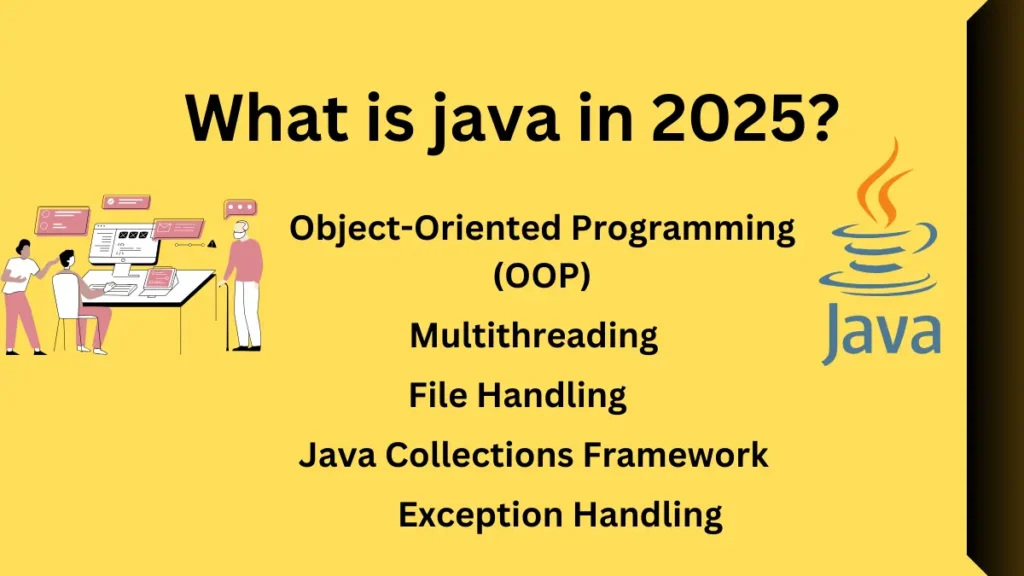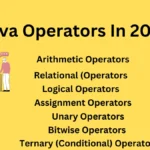What is Java and features of java?
Sun Microsystems, which is now owned by Oracle, created the Java programming language in 1995. Java applications operate on every platform on the common basis of adhering to the “Write Once, Run Anywhere” principle through a Java Virtual Machine (JVM). Today, Java is something of a ubiquitous programming language and finds its applications in any and all embedded systems, enterprise applications, mobile applications (Android), and development of web applications. Its advantages are that it boasts great safety features, automatic memory management, and multi-threading capabilities. It still stands out as one of the most commonly known programming languages by developers around the world thanks to its extensive library and frameworks. an object-oriented, high-level programming language created by Sun Microsystems, which is currently owned by Oracle. It is frequently used to create enterprise-level software, mobile applications, and web applications.

what are the Features of Java?
Platform Independent: WORA stands for “write once, run anywhere.”
Object-Oriented: Uses OOP concepts such as abstraction, encapsulation, inheritance, and polymorphism.
Secure: Provides security features and runtime checks.
Multiple threads can be executed concurrently thanks to multithreading.
Robust: Excellent handling of exceptions and memory management.
High Performance: Optimizes using a Just-In-Time (JIT) compiler.
how to Install Java in Your system?
- Download and install the latest Java Development Kit (JDK) from Oracle or OpenJDK.
- Set up Environment Variables (
JAVA_HOMEandPATH). - Verify installation using:
- java -version
What are the Fundamentals of java?
Java Syntax and Structure:
A basic Java program structure:
public class HelloWorld {
public static void main(String[] args) {
System.out.println("Hello, World!");
}
}Variables and Data Types In java?
Java has different types of variables to store data values. Data types are primarily classified into two categories: primitive data types and reference data types.
Primitive Data Types
The primitive data types represent the most basic types that, in turn, store simple values.
byte (1 byte): It stores the whole numbers from -128 to +127.
short (2 bytes): It stores whole numbers from -32,768 to +32,767.
int (4 bytes): It stores whole numbers ranging from -2^31 to 2^31-1.
long (8 bytes): It stores large whole numbers ranging from -2^63 to 2^63-1.
float (4 bytes): It stores fractional numbers with up to 7 decimal digits.
double (8 bytes): It stores fractional numbers with up to 16 decimal digits.
char (2 bytes): It stores a single character.
boolean (1 bit): It stores true or false.
Reference Data Types in java
Reference data types are used to store objects that are not predefined in Java.
Strings (String): For storing text.
Arrays (int[], double[], etc.): For storing multiple values of the same type.
Objects (Instances of user-defined classes).
what are the Operators in Java?
👉Here is Detail guide for Java Operators In 2025
Operators in Java are special symbols or keywords that carry out operations on variables and values. Considering that Java has many operators, operations like arithmetic calculation, comparisons, and logical evaluation, among other things can be performed….Java operators can be essentially classified into these categories:
- Arithmetic:
+,-,*,/,% - Relational:
==,!=,>,<,>=,<= - Logical:
&&,||,! - Assignment:
=,+=,-=,*=,/= - Bitwise:
&,|,^,~,<<,>>
Control Flow Statements of java?
Conditional Statements in java
if (condition) {
// Code
} else if (condition) {
// Code
} else {
// Code
}java Looping Statements
for (int i = 0; i < 5; i++) {
System.out.println(i);
}
while (condition) {
// Code
}
do {
// Code
} while (condition);Arrays and Strings in java?
Arrays
int[] arr = {1, 2, 3, 4};Strings
Sing s = "Hello";
System.out.println(s.length());trwhat is the Object-Oriented Programming (OOP) in java?
Object-Oriented Programming (OOP) is a paradigm in software programming based on objects instead of functions or logic. It has four basic principles.
Classes and Objects in java
class Car {
String model;
Car(String model) {
this.model = model;
}
}Inheritance in Java
class Vehicle {}
class Car extends Vehicle {}java Polymorphism example
class Animal {
void sound() { System.out.println("Animal makes a sound"); }
}
class Dog extends Animal {
void sound() { System.out.println("Bark"); }
}Exception Handling in java
try {
int x = 10 / 0;
} catch (ArithmeticException e) {
System.out.println("Cannot divide by zero");
} finally {
System.out.println("Execution completed");
}Collections Framework in java
- list (
ArrayList,LinkedList) - Set (
HashSet,TreeSet) - Map (
HashMap,TreeMap)
File Handling in java
File file = new File("test.txt");
FileWriter fw = new FileWriter(file);
fw.write("Hello, Java!");
fw.close();java Multithreading concept
class MyThread extends Thread {
public void run() {
System.out.println(“Thread is running”);
}
}


Pingback: How to create a Class in java that has an array which can accept different objects – Explore computer Science
Pingback: what are the Features of Java? – Huesnhavens
Just about all of the things you state is supprisingly accurate and that makes me wonder why I hadn’t looked at this with this light previously. Your article really did turn the light on for me personally as far as this particular subject goes. Nevertheless at this time there is actually one issue I am not too comfortable with and while I make an effort to reconcile that with the actual central idea of the issue, let me observe just what the rest of your readers have to point out.Very well done.
It is best to participate in a contest for among the finest blogs on the web. I’ll recommend this web site!
I was suggested this blog by my cousin. I’m not sure whether this post is written by him as nobody else know such detailed about my problem. You’re incredible! Thanks!